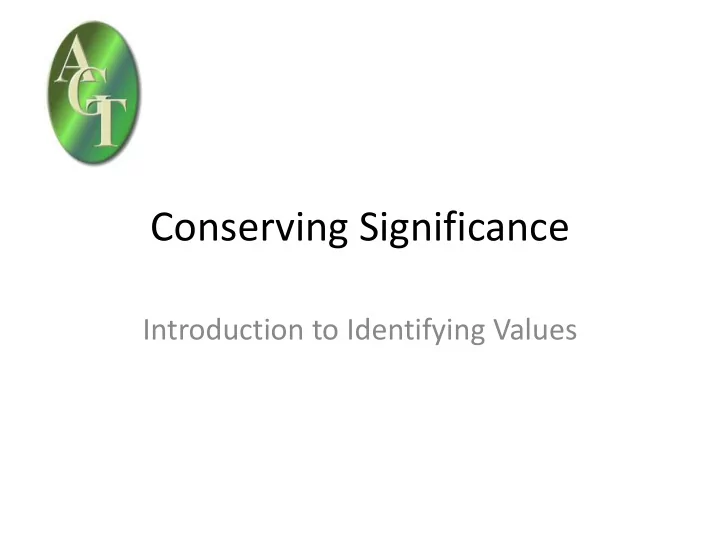

Conserving Significance Introduction to Identifying Values
Conservation defined (EH) The process of managing change to a significant place in its setting in ways that will best sustain its heritage values , while recognising opportunities to reveal or reinforce those values for present and future generations.
Why use Conservation Principles? Framework to: Identify what is important in a historic designed landscape by being able to articulate what makes it important Use this to compare relative importance of different features and areas of a landscape Decide and demonstrate whether proposed changes would affect, positively or negatively, what matters in a designed landscape
The Concepts • Conservation Principles – the overarching framework for careful and considered management • Values – these describe the aspects or qualities of worth or importance that a place may have These principles and values are then used to lay out processes for assessing the heritage significance of a place and managing change to significant places. • Significance – the sum of the cultural and natural heritage values of a place
(Selected) Conservation Principles Principle 3 – Understanding the significance of places is vital Principle 4 – Significant places should be managed to sustain their values Principle 5 – Decisions about change must be reasonable, transparent and consistent
Understanding Values Evidential value Historical value • Illustrative • Associative Aesthetic value • Design • Artistic • Fortuitous Communal value • Commemorative and symbolic • Social • Spiritual Sum of all these = Significance
Evidential value The potential of a place to yield new evidence about past human activity
Historical values Ways in which past people, events and aspects of life can be connected through a place to the present Associative Illustrative
Aesthetic values Ways in which people draw sensory and intellectual stimulation from a place Fortuitous Designed
Communal values The meanings of a place for the people who relate to it, or for whom it figures in their collective experience or memory Social Commemorative Spiritual
Assessing Significance • Understand the fabric and evolution of the place • Identify who values the place and why
… Assessing Significance • Relate identified heritage values to the fabric/features of the place • Consider the relative importance of those identified values
… Assessing Significance • Consider the contribution of associated objects and collections • Consider the contribution made by setting and context
• Insert example of painting etc or item from archive that might strengthen or support a place’s significance
…Assessing Significance • Compare the place with other places sharing similar values • Articulate the significance of the place
A tool to help Evidential Historical Aesthetic Communal Feature Fieldtree Park Northern Park Lake Temple Kitchen Garden View to tower
• Insert extract from statement of significance as an example
EH Register – Thornes Park Summary of Garden Thornes Park is a public park consisting of three historically distinct areas of landscaping, the earliest dating from the later C18. The public park was opened in 1891, with additions in 1919 and 1924. Reasons for Designation Thornes Park, Wakefield, is designated at Grade II for the following principal reasons: * Survival: It is a good example of an urban municipal park of the late C19 and early C20 where the layout survives almost intact * Historic Interest: it has added interest in the incorporation of a late C18 landscape possibly designed by John Carr, as well as a scheduled medieval motte and bailey castle earthwork.
EH Register – Gisburne Park Summary of Garden An early C18 formal garden and deer park associated with Gisburne Hall, overlain by an C18 landscaped park. Reasons for Designation This C18 formal garden and deer park, overlain by a landscaped park is designated at Grade II for the following principal reasons: * Historic interest: the integrity of the early C18 formal garden and deer park phase is preserved and is highly visible * Historic interest: despite some loss of character in parts, it is a good example of a mid and later C18 landscaped park in the English natural style, and sufficient of its original landscaping survives to reflect its original design * Design influence: some elements of the landscaping appear to reflect the influence of a proposed early C18 design by Lord Robert Petre on subsequent generations of the Lister family * Group value: it has strong group value with a number of listed buildings including the Grade II* gate lodges and the Grade I Gisburne Hall * Tree nursery: the presence of the 'Great Nursery' on Coppy Hill is a striking and unusual feature.
Canterbury City Council Statement of Significance – Memorial Park, Herne Bay (2007) 4.0 Significance: why do we value it as part of our heritage? 4.1 General statement of significance Memorial Park was completed in the mid 1930’s. It is therefore only 77 years old at the time of writing which makes it a relatively recent park. It was originally conceived as a memorial to those that lost their lives in the First World War. Despite its relative young age the park now forms an integral part of the town. It possesses a number of original elements which are significant and need to be retained and conserved. Apart from these there is a wide range of features which could be changed of removed to adapt the park for present-day usage.
How can this relate to the work of CGTs? Understanding and applying these principles can be used to - help assess the impact of development on a landscape - decide whether a developer has addressed significance in planning applications - articulate the case for local listing of a landscape - pinpoint what is important to convey about a site in visits, research reports, leaflets etc
Recommend
More recommend